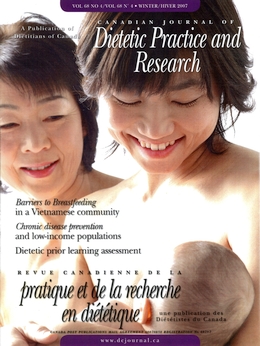Abstract
Purpose: Iron deficiency anemia (IDA) during pregnancy and infancy is still common in developed countries, especially in low-income groups. We examined the prevalence of anemia and IDA in healthy low-income pregnant women participating in the Early Childhood Initiatives (ECI) program, and in their infants when they reached six months of age.
Methods: Pregnant women were recruited by nutritionists. In mothers, hemoglobin (Hb), mean corpuscular volume, and serum ferritin (SF) were measured at 36 ± 2 weeks of gestation. In infants, Hb, mean corpuscular volume, SF, serum iron, total iron binding capacity (TIBC), and transferrin saturation (TS) were measured at six months of age. Thirty-one mother-infant pairs participated.
Results: Among the 31 pregnant women participating in the ECI program, six (19.4%) were anemic (Hb <110 g/L) and five (16.1%) suffered from IDA (Hb <110 g/L and SF <10 µg/L). Among infants, seven of 23 (30.4%) were anemic (Hb <110 g/L) and five of 23 (21.7%) suffered from IDA (Hb <110 g/L plus two of the following: TIBC >60 µmol/L, SF <10 µg/L, serum iron <5.3 µmol/L, TS ≤15%).
Conclusions: The prevalence of anemia in this group of lowincome pregnant women is comparable to that in privileged women. The prevalence of IDA in infants is comparable to that observed in other high-risk groups. Effective strategies are needed to prevent IDA in vulnerable groups.
Résumé
Objectif: L’anémie ferriprive (AF) chez la femme enceinte et le nourrisson est encore courante dans les pays industrialisés, en particulier chez les groupes à faible revenu. Nous avons examiné la prévalence de l’anémie et de l’AF chez des femmes enceintes en bonne santé à faible revenu participant au programme Initiatives pour la petite enfance (IPE) et chez leurs nourrissons de six mois.
Méthodes: Les femmes enceintes ont été recrutées par des nutritionnistes. Chez les mères, l’hémoglobine (Hb), le volume globulaire moyen et la ferritine sérique (FS) ont été mesurés à 36 ± 2 semaines de grossesse. Chez les nourrissons, l’Hb, le volume globulaire moyen, la FS, le fer sérique, la capacité totale de fixation du fer (CTFF) et la saturation de la transferrine (ST) ont été mesurés à six mois. Au total, 31 paires mère-enfant ont participé à l’étude.
Résultats: Parmi les 31 femmes enceintes participant au programme IPE, six (19,4%) étaient anémiques (Hb <110 g/L) et cinq (16,1%) souffraient d’AF (Hb <110 g/L et FS <10 µg/L). Parmi les nourrissons, sept sur 23 (30,4%) étaient anémiques (Hb <110 g/L) et cinq sur 23 (21,7%) souffraient d’AF (Hb <110 g/L plus deux des paramètres suivants: CTFF> 60 µmol/L, FS<10 µg/L, fer sérique <5,3 µmol/L, ST ≤15%).
Conclusions: La prévalence de l’anémie dans ce groupe de femmes enceintes à faible revenu est comparable à celle des femmes à plus haut revenu. La prévalence de l’AF chez les nourrissons est comparable à celle observée dans d’autres groupes à risque élevé. Il est nécessaire de trouver des stratégies efficaces pour prévenir l’AF chez les groupes vulnérables.



